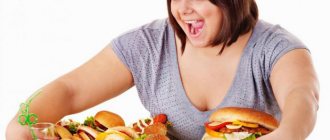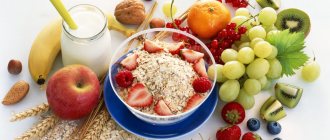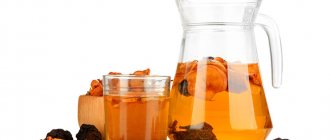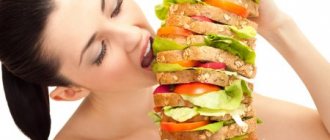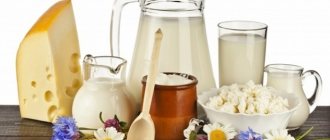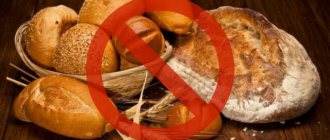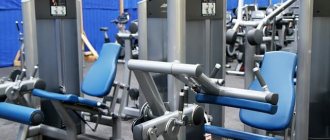General rules
The concept of a “student lifestyle” is associated with a high and disordered pace of life, frequent stress and sleepless nights caused by periodic tests and exams, insufficient or, conversely, increased physical activity, lack of sleep, and frequent emotional outbursts.
All this, superimposed on the nutritional habits of students (irregularity of meals, dry meals, snacks on the go, replacing breakfast with a cup of coffee, abuse of energy drinks - tea, coffee) negatively affects the body as a whole and especially the gastrointestinal tract. And if the need to eat food and its quantity is signaled by a periodically arising feeling of hunger, then most students do not even think about the quality of food. To this is often added an acute lack of time, laziness/inability to cook for oneself, and the desire to save on food.
Accordingly, the majority of student diets are based on instant foods (various types of brewed noodles, soups/cereals in bags), sandwiches with butter, sausage/cheese, as well as fast food products (burgers, pies, hot dogs, buns, French fries, various chips, salted nuts, rolls), which are often washed down with sweet carbonated drinks, beer, energy drinks, coffee.
Such nutrition contributes to the development of gastritis with frequent exacerbations, decreased performance, vitamin deficiencies , and impaired development of the body, which still continues at this age. At the same time, proper organization of student meals is quite simple and does not require a lot of time and money. It is enough to understand that nutrition during student years largely determines the state of health in subsequent periods of life and the desire to change it.
Proper nutrition of students is based on a rational and balanced diet, providing the students’ body with all nutritional macro/micronutrients. The diet for students should include natural products as much as possible - lean meat, fish, cheese, cottage cheese, lactic acid products, butter, cereals, vegetables, fruits from which, even with the simplest culinary skills, you can prepare very simple dishes. In addition, in the era of the Internet, you can easily find a lot of recipes for any combination of products and any complexity, and with the purchase of modern kitchen appliances, in particular a multicooker, blender, and toaster, you can cook with a minimum of time.
Try to avoid various kinds of canned food and semi-finished products, which are often prepared from not entirely fresh products, and also include various kinds of food additives (preservatives, dyes). Eliminate/limit as much as possible the consumption of all drinks with dyes (Coca, Pepsi, energy drinks), fast food chain meals, and snack products (salted nuts, chips, seeds, crackers).
Rational nutrition of students should be based on the following principles:
- There should be at least three meals with 1-2 additional snacks, which ensures good digestibility of food and prevents the accumulation of fat in the body. You should focus on a 3-hour break in food intake.
- Taking it in the morning should provide you with enough energy. This requires carbohydrates and quickly digestible protein. Porridges (buckwheat, rice, oatmeal, wheat) are best suited for this purpose, to which you can add a little butter, herbs, vegetables, fruits/dried fruits/nuts (to oatmeal). As a protein product, it is better to choose chicken eggs, from which you can very quickly prepare an omelet (with the addition of cheese, vegetables), scrambled eggs, or simply boil them. Also a good option is cottage cheese with low-fat sour cream and fruit. Preparing such dishes is extremely simple. If you have very little time or you constantly wake up in the morning, then whole grain cereals can be poured with salted boiling water in a thermos overnight, and in the morning you will get an extremely healthy product. By adding a little oil and combining it with an omelette, you will get a complete and healthy diet. Drinks for the morning include tea, coffee with milk, and juices. Try not to skip breakfast and not replace it with a cup of tea/coffee and a bun.
- Proper nutrition requires that lunch must contain hot, thermally processed solid or liquid food. Warm food is more fully absorbed by the body and nutrients enter the blood faster. It is better that lunch, if possible, contains a first course. Soups made with various broths are optimal for this purpose. It is only necessary to prepare broth, for example, chicken broth, which should be stored in the refrigerator, once every 2-3 days. And every day, cook any soup using broth with the addition of cereals, vegetables and herbs. It is imperative to include protein foods in the form of meat, fish with vegetables/vegetable salad for lunch. And you don’t have to invent anything special - just fry the meat or fish. It is better to combine meat with vegetables and not necessarily raw ones. Currently, almost all supermarkets sell a large selection of canned vegetables - cucumbers, tomatoes, lecho, salads, corn, green peas. It is recommended to consume predominantly rye (bran/grain) bread.
- Dinner should not be just before going to bed and not very rich. Don't replace all meals with a large dinner. Any dairy products, cheese, chicken breast, fish, vegetable salads with added vegetable oils, and fruits are suitable. It is necessary to have dinner not late. Even if you need to work out late, try not to eat anything else, or if you have a strong appetite, take natural yogurt or kefir.
A few words about snacks. Do not use bread and sausage sandwiches with butter and cheese for these purposes. Firstly, this is dry food, and secondly, in this way you are trying to replace one of the meals. For these purposes, it is better to use yogurt, kefir or fermented baked milk, and fruit. Or, if you are forced to skip one of the main meals, the best option would be a piece of boiled meat (chicken/beef) with vegetables. Don’t be lazy to prepare yourself such a snack.
Briefly about the diet for girls who periodically strive to lose a few kilograms, in their opinion, excess weight. First of all, do not practice various kinds of strict mono-diets on certain foods. As a rule, weight after such diets returns to its previous levels, and often exceeds them. A diet for a student to lose weight should be based on the principles of healthy eating, and the process of losing weight should be relatively slow. To do this, it is enough to adjust your diet by reducing its calorie content.
Eliminate various bagged cereals from your diet. The glycemic index of such instant foods goes beyond 80-90, while the index of whole grain cereals is only 40-45, which is important for girls trying to lose weight. Reduce your consumption of pasta, sugar, bakery and confectionery products, various types of sweets, sweet carbonated drinks and increase the proportion of vegetables, fruits, and dairy products. At the same time, increase your physical activity and your weight will quickly return to normal.
A few words about nutrition during sessions with increased mental stress. In addition to a balanced diet, it is necessary to consume foods that improve brain function and foods that have an anti-stress effect. First of all, it is dark chocolate (72-74% cocoa) in an amount of 25-30 g/day, which has a low glycemic index (about 30), which quickly increases blood sugar levels, promotes the production of endorphin (the hormone of joy) and has a beneficial effect on health. brain function (improves cerebral blood flow, memory and concentration, increases performance).
Also useful during this period are honey with walnuts and bananas, rich in dopamine, which give a slight relaxing effect and improve night sleep. During this period, you should not abuse coffee, tea, or energy drinks, which have a short-term effect, and in the future, under conditions of increased brain function, lead to inhibition of the central nervous system, fatigue, and disruption of the rhythm of sleep and wakefulness.
It is advisable to drink coffee only in the first half of the day (1-2 cups) and it is better not to use only natural, instant “drink”. Be sure to drink 1.5-2 liters of purified/mineral drinking water throughout the day. Taking vitamin and mineral complexes, as well as morning exercises and walking, will not be amiss during this period.
If you properly organize a student’s nutrition and adhere to these simple principles from the very beginning of his student period, then he will not have to go to the doctor for problems with the gastrointestinal tract and will not have to think about weight loss diets.
What foods should students eat?
Students are people who study a lot and constantly strain their brains. So, to maintain brain tone, it is necessary to include the following foods in your diet:
- garlic - it accelerates blood circulation, saturates the brain with oxygen and ultimately improves memory;
- honey – the glucose contained in it improves memory;
- milk – vitamin B12 present in it promotes better memory;
- lemon – vitamin C prevents forgetfulness and helps retain information in the head;
- red and purple grapes – improves the nutrition of gray cells and protects them from destruction;
- walnuts – the vitamins B and E they contain stimulate the functioning of brain cells and develop thinking;
- water - the body of all people consists of 80% water, and the brain is 90%, so you need to drink at least 8 glasses of water a day to maintain the elasticity of the gray matter. Water also speeds up the body's metabolism, which is very important for losing weight.
Authorized Products
The diet for students includes a wide range of natural products:
- Soups in various broths with the addition of vegetables and whole grains.
- Any fish and seafood: squid, mussels, crabs, shrimp, seaweed.
- Rye/grain bread with bran, whole grain bread.
- Lean meats (chicken and turkey, beef, rabbit), sausages, stewed meats.
- Cereals, mainly whole grains (brown rice, buckwheat, pearl barley, millet, oatmeal), wholemeal pasta.
- Chicken eggs in any form. It is useful to supplement omelettes with mushrooms, cheese, herbs and vegetables.
- Moderately fatty dairy and fermented milk products (cheese, cottage cheese, feta cheese, butter, sour cream, cream, kefir, milk, fermented baked milk, yogurt).
- Cold-pressed vegetable oils (linseed, olive, sunflower), sesame.
- Freshly prepared juices, herbal/green tea with ginger and lemon, rosehip infusion, mineral water.
Table of permitted products
| Proteins, g | Fats, g | Carbohydrates, g | Calories, kcal | |
Vegetables and greens | ||||
| greenery | 2,6 | 0,4 | 5,2 | 36 |
| eggplant | 1,2 | 0,1 | 4,5 | 24 |
| beans | 6,0 | 0,1 | 8,5 | 57 |
| zucchini | 0,6 | 0,3 | 4,6 | 24 |
| cabbage | 1,8 | 0,1 | 4,7 | 27 |
| broccoli | 3,0 | 0,4 | 5,2 | 28 |
| boiled cauliflower | 1,8 | 0,3 | 4,0 | 29 |
| bulb onions | 1,4 | 0,0 | 10,4 | 41 |
| carrot | 1,3 | 0,1 | 6,9 | 32 |
| cucumbers | 0,8 | 0,1 | 2,8 | 15 |
| salad pepper | 1,3 | 0,0 | 5,3 | 27 |
| radish | 1,2 | 0,1 | 3,4 | 19 |
| white radish | 1,4 | 0,0 | 4,1 | 21 |
| red radish | 1,2 | 0,1 | 3,4 | 20 |
| black radish | 1,9 | 0,2 | 6,7 | 35 |
| salad | 1,2 | 0,3 | 1,3 | 12 |
| beet | 1,5 | 0,1 | 8,8 | 40 |
| celery | 0,9 | 0,1 | 2,1 | 12 |
| soybeans | 34,9 | 17,3 | 17,3 | 381 |
| asparagus | 1,9 | 0,1 | 3,1 | 20 |
| tomatoes | 0,6 | 0,2 | 4,2 | 20 |
| Jerusalem artichoke | 2,1 | 0,1 | 12,8 | 61 |
| pumpkin | 1,3 | 0,3 | 7,7 | 28 |
| beans | 7,8 | 0,5 | 21,5 | 123 |
| horseradish | 3,2 | 0,4 | 10,5 | 56 |
| garlic | 6,5 | 0,5 | 29,9 | 143 |
| lentils | 24,0 | 1,5 | 42,7 | 284 |
| spinach | 2,9 | 0,3 | 2,0 | 22 |
| sorrel | 1,5 | 0,3 | 2,9 | 19 |
Fruits | ||||
| avocado | 2,0 | 20,0 | 7,4 | 208 |
| oranges | 0,9 | 0,2 | 8,1 | 36 |
| bananas | 1,5 | 0,2 | 21,8 | 95 |
| pomegranate | 0,9 | 0,0 | 13,9 | 52 |
| grapefruit | 0,7 | 0,2 | 6,5 | 29 |
| pears | 0,4 | 0,3 | 10,9 | 42 |
| melon | 0,6 | 0,3 | 7,4 | 33 |
| figs | 0,7 | 0,2 | 13,7 | 49 |
| kiwi | 1,0 | 0,6 | 10,3 | 48 |
| lemons | 0,9 | 0,1 | 3,0 | 16 |
| mango | 0,5 | 0,3 | 11,5 | 67 |
| tangerines | 0,8 | 0,2 | 7,5 | 33 |
| nectarine | 0,9 | 0,2 | 11,8 | 48 |
| peaches | 0,9 | 0,1 | 11,3 | 46 |
| apples | 0,4 | 0,4 | 9,8 | 47 |
Berries | ||||
| grape | 0,6 | 0,2 | 16,8 | 65 |
| gooseberry | 0,7 | 0,2 | 12,0 | 43 |
| Red currants | 0,6 | 0,2 | 7,7 | 43 |
| black currant | 1,0 | 0,4 | 7,3 | 44 |
Mushrooms | ||||
| mushrooms | 3,5 | 2,0 | 2,5 | 30 |
Nuts and dried fruits | ||||
| nuts | 15,0 | 40,0 | 20,0 | 500 |
| raisin | 2,9 | 0,6 | 66,0 | 264 |
| cashew | 25,7 | 54,1 | 13,2 | 643 |
| sesame | 19,4 | 48,7 | 12,2 | 565 |
| flax seeds | 18,3 | 42,2 | 28,9 | 534 |
| fenugreek seeds | 23,0 | 6,4 | 58,3 | 323 |
| sunflower seeds | 20,7 | 52,9 | 3,4 | 578 |
Cereals and porridges | ||||
| buckwheat (kernel) | 12,6 | 3,3 | 62,1 | 313 |
| oat groats | 12,3 | 6,1 | 59,5 | 342 |
| cereals | 11,9 | 7,2 | 69,3 | 366 |
| millet cereal | 11,5 | 3,3 | 69,3 | 348 |
Flour and pasta | ||||
| pancakes | 6,1 | 12,3 | 26,0 | 233 |
Confectionery | ||||
| jam | 0,3 | 0,1 | 56,0 | 238 |
| jam | 0,4 | 0,2 | 58,6 | 233 |
Chocolate | ||||
| chocolate | 5,4 | 35,3 | 56,5 | 544 |
Raw materials and seasonings | ||||
| seasonings | 7,0 | 1,9 | 26,0 | 149 |
| mustard | 5,7 | 6,4 | 22,0 | 162 |
| honey | 0,8 | 0,0 | 81,5 | 329 |
| vinegar | 0,0 | 0,0 | 5,0 | 20 |
Dairy | ||||
| skim milk | 2,0 | 0,1 | 4,8 | 31 |
| natural yogurt 2% | 4,3 | 2,0 | 6,2 | 60 |
Cheeses and cottage cheese | ||||
| amber processed cheese | 7,0 | 27,3 | 4,0 | 289 |
| cottage cheese 1% | 16,3 | 1,0 | 1,3 | 79 |
| curd tofu | 8,1 | 4,2 | 0,6 | 73 |
Meat products | ||||
| pork liver | 18,8 | 3,6 | 0,0 | 108 |
| pork kidneys | 13,0 | 3,1 | 0,0 | 80 |
| beef | 18,9 | 19,4 | 0,0 | 187 |
| beef liver | 17,4 | 3,1 | 0,0 | 98 |
| beef kidneys | 12,5 | 1,8 | 0,0 | 66 |
| rabbit | 21,0 | 8,0 | 0,0 | 156 |
| bacon | 23,0 | 45,0 | 0,0 | 500 |
Sausages | ||||
| boiled sausage | 13,7 | 22,8 | 0,0 | 260 |
| smoked sausage | 9,9 | 63,2 | 0,3 | 608 |
| sausages | 10,1 | 31,6 | 1,9 | 332 |
| sausages | 12,3 | 25,3 | 0,0 | 277 |
Bird | ||||
| chicken fillet | 23,1 | 1,2 | 0,0 | 110 |
| turkey | 19,2 | 0,7 | 0,0 | 84 |
Eggs | ||||
| eggs | 12,7 | 10,9 | 0,7 | 157 |
Fish and seafood | ||||
| fish | 18,5 | 4,9 | 0,0 | 136 |
| cod roe | 24,0 | 0,2 | 0,0 | 115 |
| squid | 21,2 | 2,8 | 2,0 | 122 |
| mussels | 9,1 | 1,5 | 0,0 | 50 |
| seaweed | 0,8 | 5,1 | 0,0 | 49 |
Oils and fats | ||||
| butter | 0,5 | 82,5 | 0,8 | 748 |
| linseed oil | 0,0 | 99,8 | 0,0 | 898 |
| olive oil | 0,0 | 99,8 | 0,0 | 898 |
| sunflower oil | 0,0 | 99,9 | 0,0 | 899 |
Non-alcoholic drinks | ||||
| mineral water | 0,0 | 0,0 | 0,0 | — |
| coffee | 0,2 | 0,0 | 0,3 | 2 |
| green tea | 0,0 | 0,0 | 0,0 | — |
| black tea | 20,0 | 5,1 | 6,9 | 152 |
| * data is per 100 g of product | ||||
Fully or partially limited products
The diet for students limits the consumption of:
- Fatty, high-calorie foods, especially at night.
- Fatty meats, canned fish, meat/fish semi-finished products.
- Dairy products with high fat content.
- Cakes, pastries, puff pastry and pastry products, cream pies, semolina.
- Alcoholic drinks, instant coffee, carbonated sweet drinks (cola, tonic, sprite), energy drinks.
Table of prohibited products
| Proteins, g | Fats, g | Carbohydrates, g | Calories, kcal | |
Snacks | ||||
| potato chips | 5,5 | 30,0 | 53,0 | 520 |
Cereals and porridges | ||||
| white rice | 6,7 | 0,7 | 78,9 | 344 |
Flour and pasta | ||||
| pasta | 10,4 | 1,1 | 69,7 | 337 |
| pancakes | 6,3 | 7,3 | 51,4 | 294 |
Bakery products | ||||
| buns | 7,2 | 6,2 | 51,0 | 317 |
Confectionery | ||||
| pastry cream | 0,2 | 26,0 | 16,5 | 300 |
| cake | 3,8 | 22,6 | 47,0 | 397 |
| dough | 7,9 | 1,4 | 50,6 | 234 |
| halva | 11,6 | 29,7 | 54,0 | 523 |
Cakes | ||||
| cake | 4,4 | 23,4 | 45,2 | 407 |
Raw materials and seasonings | ||||
| mayonnaise | 2,4 | 67,0 | 3,9 | 627 |
| sugar | 0,0 | 0,0 | 99,7 | 398 |
Dairy | ||||
| milk 3.2% | 2,9 | 3,2 | 4,7 | 59 |
| condensed milk | 7,2 | 8,5 | 56,0 | 320 |
Cheeses and cottage cheese | ||||
| cottage cheese 18% (fat) | 14,0 | 18,0 | 2,8 | 232 |
Meat products | ||||
| fatty pork | 11,4 | 49,3 | 0,0 | 489 |
| pork fat | 1,4 | 92,8 | 0,0 | 841 |
| salo | 2,4 | 89,0 | 0,0 | 797 |
Bird | ||||
| duck | 16,5 | 61,2 | 0,0 | 346 |
| goose | 16,1 | 33,3 | 0,0 | 364 |
Fish and seafood | ||||
| canned fish | 17,5 | 2,0 | 0,0 | 88 |
| semi-finished fish products | 12,5 | 6,7 | 14,7 | 209 |
Oils and fats | ||||
| creamy margarine | 0,5 | 82,0 | 0,0 | 745 |
| coconut oil | 0,0 | 99,9 | 0,0 | 899 |
| vegetable-fat spread | 0,0 | 40,0 | 0,0 | 360 |
| animal fat | 0,0 | 99,7 | 0,0 | 897 |
| cod liver oil | 0,0 | 99,8 | 0,0 | 898 |
| cooking fat | 0,0 | 99,7 | 0,0 | 897 |
Alcoholic drinks | ||||
| white dessert wine 16% | 0,5 | 0,0 | 16,0 | 153 |
| vodka | 0,0 | 0,0 | 0,1 | 235 |
| cognac | 0,0 | 0,0 | 0,1 | 239 |
| liquor | 0,3 | 1,1 | 17,2 | 242 |
| beer | 0,3 | 0,0 | 4,6 | 42 |
Non-alcoholic drinks | ||||
| cola | 0,0 | 0,0 | 10,4 | 42 |
| instant coffee dry | 15,0 | 3,5 | 0,0 | 94 |
| Pepsi | 0,0 | 0,0 | 8,7 | 38 |
| sprite | 0,1 | 0,0 | 7,0 | 29 |
| energy drink | 0,0 | 0,0 | 11,3 | 45 |
| * data is per 100 g of product | ||||
Food for one week
Experts recommend purchasing the following products for the week, from which you will prepare meals:
The daughter of Konstantin Kinchev has a bright appearance and talent: photo
Spicy meat muffin with spinach and cream cheese: you can never have too much paprika
Flowers are not worn to Jewish graves, but why are there so many stones on them: tradition
- For breakfast, cereal, juice, milk, toast.
- 2-3 packages of pasta.
- 1 package of legumes.
- 1 whole chicken.
- 0.5 kilograms of chopped beef.
- 2 tomatoes and cucumbers each.
- 250 g cheese.
- 1 finished pizza.
- 1 packet of rice.
- 6 eggs.
Menu (Power Mode)
The foundation of proper student nutrition is a complete diet, natural products, 3-4 meals a day and the exclusion of harmful foods. Breakfast can be cottage cheese, various cereals, vegetables, eggs, yoghurt, green tea, coffee without sugar. Breakfast should be hearty (various cereals, cottage cheese, eggs, vegetables, rye bread, dairy products, green tea, coffee without sugar) so that the desire to eat does not arise after one and a half to two hours.
If you feel hungry before lunch, make a healthy snack with natural products in the form of sugar-free cottage cheese, a piece of cheese, fruit, yogurt, nuts, rye bread. If you feel hungry, you can eat some boiled chicken breast with whole grain bread. For lunch, a hot dish is required, preferably soup, fish or a meat dish with vegetables. Dinner may include baked fish, kefir, cottage cheese or vegetable salad.
Shop the right way, save money
If you go to the store without a list and don't think about what products you need, you risk spending a lot of money on unnecessary purchases.
A good trip to the supermarket involves thinking about what you would like to cook in the next few days. Think of 2-3 dishes you would like to eat, list the ingredients and make a shopping list. Also check what you have in your refrigerator or kitchen cupboard. This will allow you to successfully create multiple meals throughout the week.

Reviews and results
The diet for students is the usual rational and balanced diet. The main difficulty in complying with it lies in the low level of organization of students regarding issues of their nutrition, due to the specific way and pace of student life and a misunderstanding of its significance for health.
- “... I was taught to eat healthy since childhood, since all my parents supported a healthy lifestyle. When I became a student, the question of normal, nutritious nutrition arose. Mom immediately bought me everything I needed - several pots, a frying pan, cutlery and a pressure cooker. I knew how to cook simple dishes such as porridge, omelet, soup, potatoes before, so there were no problems with cooking. My roommates initially ate in the cafeteria, but then, when I suggested we cook together in the dorm, they agreed. Food is either delivered/transferred to everyone by train or we buy it by chipping in. By the third year, I was already a good cook, since there was a student from Uzbekistan in my class who taught me all the intricacies of oriental pilaf, a friend from Ukraine - how to cook Ukrainian borscht, and a roommate’s father how to properly cook meat and pizza. Now I’m finishing university and I can’t even imagine what it’s like to eat in public catering. I've tried it a couple of times, but it's not that tasty. I recommend that all students master this simple art and eat normally.”
What to eat for a poor student
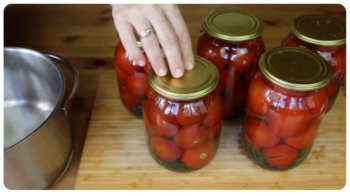
Don’t refuse your mother’s supplies - they will help out in difficult times
This question very often arises for students starting an independent life. When receiving a meager scholarship, it is difficult to distribute the money correctly and not go hungry.
Almost all of the products listed above, except for fast food and doshiraki, are quite suitable for an inexpensive student diet, but they get boring too quickly. Therefore, a few tips on how to diversify the student menu will be useful:
- Breakfast - oatmeal. It will be cheaper to buy the most ordinary one, without additives. Seasonal fruits and berries, homemade nuts and jam will help diversify it. If you have a freezer, you can freeze berries in the summer, when they are inexpensive, and add them to your breakfast all year round.
- Basic products. It is best to always have cereals, potatoes and an extra pack of pasta, buying where it is cheaper and more convenient. Even if the money runs out unexpectedly, you won’t have to starve.
- Pay attention to promotions in supermarkets. Most of them have long-standing websites with regularly updated information, so checking prices will only take a few minutes.
- Find out where the nearest inexpensive markets are located, preferably spontaneous ones, where grandmothers from the suburbs trade. The quality of fruit and vegetables there is often better than in the supermarket, and some products, such as dairy, can be found for almost half the price.
- Bargain. If you have already entered the market, you should not leave without winning at least a few rubles.
- Bring food from home. Even if you live far away, preserves and jam will never be superfluous.
